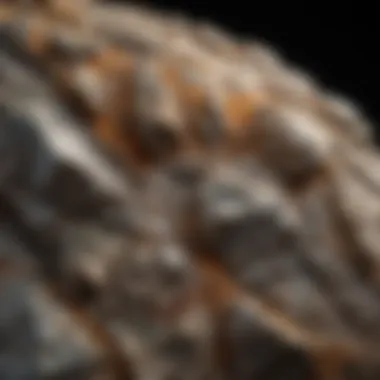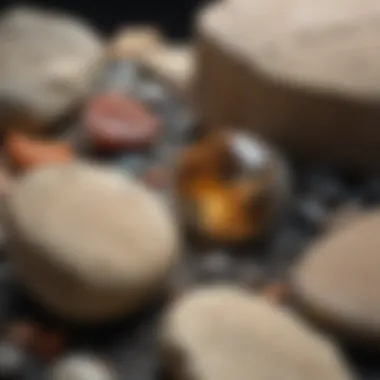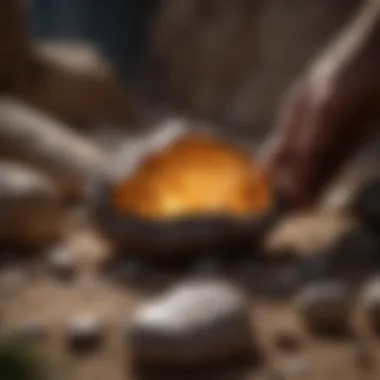Expert Guide: How to Identify Genuine Stones from Fakes for Rock and Fossil Collectors


Rock and Fossil Identification
As aspiring rock and fossil collectors embark on their journey to distinguish between genuine and counterfeit stones, a fundamental understanding of rock and fossil identification lays the groundwork for success. The diverse array of rock types, ranging from igneous to sedimentary to metamorphic rocks, presents enthusiasts with a multifaceted challenge in differentiation. Similarly, within the realm of fossils, various categories such as mold, cast, trace, and true form fossils demand meticulous observation.
Types of rocks and fossils
To acquaint oneself with the nuances of rock and fossil identification, collectors are encouraged to delve into the distinct characteristics exhibited by each category. For rocks, parameters including mineral composition, texture, and color serve as pivotal factors in classification. On the other hand, fossils reveal clues about ancient life forms through their structure, imprint, and preservation method.
Characteristics to look for
Discerning between authentic and fabricated stones necessitates honing in on specific characteristics that delineate the two. Genuine stones often exhibit natural imperfections, such as irregularities in shape or color variations, signifying their untouched origins. Conversely, artificial stones may display uniformity and artificial enhancements, posing as red flags for collectors to scrutinize with keen eyes.
Tools for identification
Equipping oneself with the appropriate tools enhances the precision of rock and fossil identification. Magnifying glasses aid in examining intricate details, while hardness picks assist in determining the hardness of specimens through scratch tests. UV lights reveal hidden fluorescence patterns, unveiling essential clues in authentication processes.
Collecting Tips and Techniques
Navigating the realm of rock and fossil collection requires enthusiasts to adopt best practices and techniques that optimize their pursuits. From selecting ideal collection sites to safely extracting specimens, collectors can elevate their experiences and broaden their acquisitions effectively.
Best practices for collecting
Implementing ethical collection practices ensures the sustainability of rock and fossil reserves for future generations. Conducting research on regulatory guidelines, seeking permissions, and respecting nature preserves are essential components in ethical collecting approaches.
Locating prime collecting sites
Identifying prime collecting sites entails comprehensive research and exploration to uncover geological hotspots abundant in diverse specimens. Collaborating with local geology clubs, attending field trips, and engaging in digital mapping tools aid collectors in pinpointing optimal locations for fruitful discoveries.
How to safely extract specimens
Ensuring the integrity of specimens during extraction is paramount to preserve their scientific and aesthetic value. Techniques such as gentle brushing, precise chiseling, and meticulous handling safeguard specimens from damage and degradation, allowing collectors to showcase their finds effectively.
Preservation and Display
Preserving the intrinsic beauty and geological significance of rocks and fossils serves as a testament to collectors' dedication to heritage conservation. Through employing specialized preservation techniques, embracing proper storage methods, and showcasing specimens creatively, collectors can immortalize their treasures for generations to come.
Techniques for preserving rocks and fossils
Implementing preservational techniques such as sealing fossils to prevent decay, storing rocks in temperature-controlled environments to deter erosion, and employing archival materials for long-term protection ensures the longevity of collections.


Proper storage methods
Adhering to proper storage methods, including utilizing acid-free containers for fossils, arranging rocks according to hardness to prevent scratching, and labeling specimens with pertinent information, facilitates organization and maintenance of collections.
Creative display ideas
Elevating the presentation of collections through creative display ideas amplifies the aesthetic appeal and educational value of rocks and fossils. Utilizing themed showcases, interactive exhibits, and informative signage engages viewers while highlighting the geological significance of each specimen.
Geological Insights
Delving into the geological realm unveils a treasure trove of insights on the processes that shape the earth's landscapes, narrating stories of ancient time periods and remarkable discoveries that redefine our understanding of the natural world.
Geological formations and processes
Exploring geological formations and processes sheds light on the forces that sculpted the earth's surface over millennia. From the formation of mountains through tectonic shifts to the creation of caves via chemical erosion, each geological process offers a glimpse into the dynamic nature of our planet.
Historical significance of rocks and fossils
Tracing the historical significance of rocks and fossils uncovers a tapestry of ancient ecosystems, extinct species, and climatic conditions that prevailed throughout geological epochs. Fossils serve as time capsules, preserving snapshots of bygone eras and offering valuable insights into the evolutionary journey of life on earth.
Notable discoveries in the field
Celebrating notable discoveries in the field of geology and paleontology showcases the relentless pursuit of knowledge and the thrill of unraveling earth's mysteries. From unearthing complete dinosaur skeletons to identifying rare mineral specimens, each discovery enriches our understanding of earth's history and the wonders that lie beneath its surface.
Introduction
As avid rock and fossil collectors, the quest for authentic stones is a paramount mission. The fundamental understanding of how to determine the genuineness of a stone is crucial in safeguarding the integrity of our collections. In this comprehensive guide, we delve into the intricate world of stones, unraveling the complexities of distinguishing real treasures from deceptive imitations. This article serves as a beacon of knowledge for enthusiasts, shedding light on the multifaceted aspects of stone authentication.
The Introduction sets the stage for our exploration into the realms of authenticity within the stone-collecting domain. By elucidating the significance of differentiating between genuine and counterfeit stones, collectors are empowered to make informed decisions when acquiring new additions to their prized collections. Emphasizing the pivotal role of authenticity, this section enlightens readers on the implications of misidentifying stones and the far-reaching consequences such errors can incur.
Delving deeper into the intricacies of stone evaluation, we unveil the methodologies and tests that form the bedrock of authentication processes. From visual inspections to weight examinations, each aspect adds a layer of proficiency to the collector's arsenal of knowledge. Through the systematic breakdown of physical examination methods, this guide equips enthusiasts with the tools to decipher the subtle nuances between real and fake stones, elevating their collection to new heights of authenticity.
Understanding the nuances of stone collecting welcomes collectors into a world where meticulous attention to detail reigns supreme. By discussing the importance of authenticity in our quest for the perfect stone, we set the foundation for a journey brimming with insights and revelations. The Introduction beckons collectors to embark on a voyage of discovery, where every stone holds secrets waiting to be revealed by the discerning eye. Welcome to the realm where authenticity reigns supreme. Welcome to the world of real and fake stones.
Understanding the Importance of Authenticity in Stone Collecting
In the enthralling realm of rock and fossil collection, the significance of authenticity transcends mere aesthetic appeal. Beyond the visual allure of stones lies a profound desire to curate genuine and rare specimens. Authenticity in stone collecting serves as the cornerstone of credibility and value within the community of enthusiasts and experts alike.
The essence of authenticity permeates every facet of stone collecting, elevating it from a hobby to a passion intertwined with scientific curiosity and historical significance. Each authentic stone represents a unique chapter in Earth's narrative, encapsulating millennia of geological processes and natural phenomena. For collectors, the quest for authentic stones is not merely about possession but a journey of discovery and preservation of Earth's ancient heritage.


Moreover, authenticity in stone collecting underscores the importance of proper documentation and provenance. Genuine stones with well-documented histories not only validate their heritage but also contribute to the broader scientific understanding of geology and paleontology. By maintaining a keen focus on authenticity, collectors uphold the integrity of their collections and safeguard against the proliferation of counterfeit or misrepresented specimens.
In essence, understanding the importance of authenticity in stone collecting is pivotal for enthusiasts to navigate the intricate world of rocks and fossils with discernment and foresight. It empowers collectors to make informed decisions, protect their investments, and cultivate a deep appreciation for the natural wonders encapsulated within each authentic stone. By prioritizing authenticity, collectors uphold the ethical standards of the hobby and perpetuate a legacy of reverence for Earth's geological treasures.
Physical Examination Methods
Physical Examination Methods play a pivotal role in the process of determining the authenticity of stones. This essential step involves closely scrutinizing various physical characteristics that can unveil valuable clues about the stone's origin and composition. By delving into the details of color, texture, and inclusions, collectors can uncover distinctive traits that differentiate real stones from fakes. Understanding these elements is critical for rock and fossil enthusiasts, as it aids in making informed decisions when evaluating specimens for their collections.
Visual Inspection
Color
Color stands out as a fundamental aspect of visual inspection when authenticating stones. The hue of a stone can provide significant insights into its type and quality. Variations in color intensity, saturation, and patterns can hint at natural formations or synthetic alterations. Observing color under different light conditions is crucial to discern any inconsistencies or artificial enhancements. Collectors must pay attention to the slightest color discrepancies as they may indicate the stone's authenticity.
Texture
Texture serves as another vital factor during visual appraisal. The surface feel of a stone can reveal key information about its formation and geological history. Smooth textures may be indicative of natural wear and aging, while rough textures could suggest external interventions or artificial treatments. Understanding the nuances of texture is essential for collectors to differentiate between genuine stones and artificially manipulated ones.
Inclusions
Examining inclusions within a stone is a sophisticated method to validate its authenticity. Natural inclusions such as minerals, gas bubbles, or internal fractures can authenticate the geological origin of a stone. The size, shape, and distribution of inclusions can offer significant clues about the stone's formation process and exposure to environmental elements. Collectors skilled in identifying unique inclusions possess a valuable asset in distinguishing real stones from counterfeit imitations.
Weight Discrepancy
Weight Discrepancy presents an intriguing aspect of physical examination methods. Discrepancies in weight can hint at potential irregularities in the stone's composition or structure. Variations in density or unexpected heaviness can alert collectors to potential imitations or artificial replacements within the stone. By carefully assessing weight variations, collectors can uncover hidden aspects of the stone's authenticity and make well-informed decisions when curating their collections.
Section 4: Conducting Simple Tests
In the realm of rock and fossil collecting, the importance of Conducting Simple Tests cannot be overstated. This pivotal aspect of the authentication process serves as a crucial checkpoint in determining the authenticity of stones. By delving into Conducting Simple Tests, collectors equip themselves with essential tools to discern between genuine and counterfeit specimens. This meticulous process involves a series of assessments that unveil key characteristics of the stone, shedding light on its true nature. Through Conducting Simple Tests, collectors gain valuable insights that aid in making informed decisions about adding stones to their prized collections.
Subsection: Scratch Test
One of the fundamental simple tests utilized in the authentication process is the Scratch Test. This method involves systematically scratching the surface of the stone with a specialized tool to assess its hardness. By observing the material's response to the scratch, collectors can gauge the stone's relative hardness, a crucial determinant in its identification. The Scratch Test offers a hands-on approach to evaluating stones, providing collectors with tangible results that contribute to the authentication process. Through this test, collectors can uncover key information about the stone's composition and integrity, aiding in differentiating between authentic and fraudulent pieces.
Subsection: Acid Test
Another indispensable simple test in the arsenal of collectors is the Acid Test. This method involves applying a diluted acid solution to the surface of the stone and observing its reaction. The Acid Test serves as a powerful tool in discerning the composition of stones, as different types of stones exhibit distinct reactions to acid. Through careful observation and analysis of the stone's response to the acid, collectors can glean crucial information about its chemical makeup, aiding in the authentication process. The Acid Test stands as a cornerstone in the toolkit of collectors, offering valuable insights into the nature of stones and facilitating the determination of their authenticity.
Subsection: UV Light Test


Among the array of simple tests available to collectors, the UV Light Test holds a prominent position in the authentication process. By subjecting the stone to ultraviolet light, collectors can observe any fluorescence or luminescence exhibited by the specimen. This test helps in identifying certain minerals or materials present in the stone that react under UV light, providing valuable clues about its composition. Through the UV Light Test, collectors can uncover hidden features of stones that are imperceptible to the naked eye, enhancing their understanding of the specimen's authenticity. This test offers a non-invasive yet powerful method for collectors to delve deeper into the composition of stones, enriching their knowledge and discernment in rock and fossil collecting.
Seeking Professional Evaluation
As we delve into the intricacies of identifying authentic stones, the importance of seeking professional evaluation emerges as a pivotal aspect in this comprehensive guide. When rock and fossil collectors encounter uncertainties or complexities in differentiating between real and fake specimens, turning to professionals with specialized knowledge and tools significantly aids in ensuring the accuracy of assessments. Seeking professional evaluation serves as a safeguard against costly mistakes and minimizes the risk of unintentionally acquiring counterfeit stones.
Moreover, the benefits of seeking professional evaluation extend beyond mere authentication. Professionals can offer valuable insights into the specific properties and characteristics of stones, shedding light on their geological significance and rarity. Through expert evaluation, collectors gain a deeper understanding of their specimens, enriching their overall appreciation and knowledge of the intricate world of rocks and fossils.
While considering seeking professional evaluation, collectors should carefully weigh certain considerations. Factors such as the credentials and expertise of the evaluator, the reputation of the evaluation service, and the cost involved in the process play vital roles in determining the reliability and integrity of the evaluation. Verifying the legitimacy and credibility of the professionals engaged in the evaluation is crucial to ensuring accurate and reliable results.
In essence, seeking professional evaluation elevates the authenticity verification process for rock and fossil collectors, offering a specialized and meticulous approach that complements the investigative methods discussed in earlier sections. By enlisting the expertise of qualified professionals, collectors not only safeguard the integrity of their collections but also embark on a journey of exploration and discovery guided by expert knowledge and insight.
Common Types of Fake Stones
In the realm of rock and fossil collecting, understanding the common types of fake stones holds paramount significance. As avid enthusiasts delve into the intricate world of geological treasures, being able to discern authentic specimens from their counterfeit counterparts becomes a crucial skillset in their pursuit. By shedding light on the prevalent forms of fake stones circulating in the market, this section aims to empower collectors with the knowledge necessary to identify and avoid potential pitfalls.
One of the key elements to consider when exploring the common types of fake stones is the prevalence of imitation gemstones made to mimic renowned and valuable minerals. These synthetic replicas often replicate the appearance of coveted stones like diamonds, emeralds, or sapphires, presenting collectors with visually appealing but deceptive specimens. By familiarizing themselves with the characteristic features of these imitation gemstones, collectors can equip themselves with the discernment needed to differentiate between authentic gemstones and their synthetic counterparts.
Furthermore, the section delves into the realm of composite stones, where multiple materials are combined to create an artificial replica of a natural gemstone. This practice not only deceives collectors by simulating the appearance of genuine stones but also diminishes the intrinsic value and authenticity of the specimens. Understanding the common compositions used in composite stones allows collectors to identify telltale signs that indicate a stone's synthetic nature, ensuring that their collections remain authentic and valuable.
In addition to imitation gemstones and composite stones, the section also covers the deceptive practice of treating natural stones to enhance their appearance artificially. Treatments such as dyeing, irradiation, or heating are employed to conceal imperfections, improve color, or simulate rare features in gemstones. By exploring these artificial enhancements and the impact they have on a stone's authenticity, collectors can sharpen their discernment and validate the genuine nature of their prized specimens.
Overall, delving into the common types of fake stones serves as a critical undertaking for rock and fossil collectors seeking to fortify their expertise and preserve the integrity of their collections. By unraveling the intricacies of synthetic gemstones, composite materials, and treated specimens, collectors can navigate the complex landscape of valuable stones with confidence and precision.
Preserving and Displaying Authentic Stones
Preserving and displaying authentic stones occupies a critical space in the realm of rock and fossil collecting. As avid collectors know, the integrity of a specimen is not solely defined by its authenticity but also by how well it is preserved and showcased. Preserving stones ensures their longevity and maintains their inherent value. A properly preserved stone retains its visual appeal and scientific significance, making it a prized addition to any collection. Equally important is the aspect of displaying these authentic stones. Displaying techniques serve not only an aesthetic purpose but also act as educational tools, allowing enthusiasts to appreciate the diverse characteristics of each specimen. The manner in which authentic stones are presented can enhance the overall collecting experience, turning a mere hobby into a captivating journey of discovery.
Storage Tips
Effective storage tips play a pivotal role in preserving the authenticity of stones. Ensuring proper storage conditions help prevent degradation and safeguard the integrity of the specimens. Store stones in a cool, dry place away from direct sunlight to prevent discoloration or damage. It is advisable to package stones individually or provide ample cushioning to prevent abrasions. For more delicate specimens, such as fossils, consider using acid-free tissue paper or foam to protect fragile areas. Additionally, organizing stones based on their hardness or fragility can minimize the risk of unintentional damage. Regularly inspect stored stones for any signs of deterioration and make necessary adjustments to maintain their pristine condition.
Display Techniques
Selecting appropriate display techniques is paramount in showcasing the beauty and uniqueness of authentic stones. Display methods should align with the characteristics of each specimen to highlight their individuality. Utilize stands, frames, or shadow boxes to elevate stones for better visibility and aesthetic appeal. Group stones with similar properties or geological significance to create thematic displays that offer insight into their origins and formation. Incorporating labels with relevant information enhances the educational value of the display, providing viewers with meaningful context. Rotating displays periodically not only prevents light damage but also keeps the collection fresh and engaging. Experimenting with different arrangements and lighting angles can reveal varying aspects of stones, enriching the viewing experience for collectors and visitors alike.
Conclusion
In this comprehensive guide on determining the authenticity of stones, the Conclusion section plays a pivotal role in summarizing the key aspects covered throughout the article. Understanding the importance of accurately differentiating between real and fake stones is paramount for rock and fossil collectors to build a reputable collection. The significance of the Conclusion lies in its ability to reinforce the need for vigilance and thorough examination when acquiring new specimens.
By highlighting the essential points discussed in the preceding sections, the Conclusion serves as a synthesis of information. Rock and fossil collectors gain valuable insights into identifying common types of fake stones, conducting necessary tests, and preserving authentic specimens. This conclusive section underscores the critical role that proper authentication techniques play in maintaining the integrity and value of one's collection.
Moreover, the Conclusion provides a nuanced perspective on the broader significance of authenticity in stone collecting. It emphasizes the satisfaction and fulfillment that collectors derive from acquiring genuine specimens, free from any deceptive alterations. By fostering a culture of diligence and precision, this guide empowers enthusiasts to make informed decisions and enhance their expertise in discerning real from fake stones.
In essence, the Conclusion encapsulates the essence of the entire guide, reinforcing the importance of meticulous examination and knowledge in the realm of stone authenticity. It serves as a final reflection point for readers, solidifying their understanding of the complexities involved in verifying the legitimacy of stones and emphasizing the rewards that come with a discerning approach to collection building.







